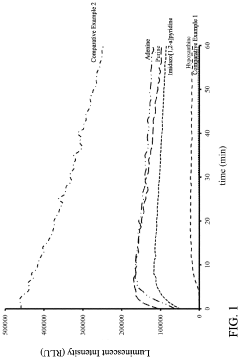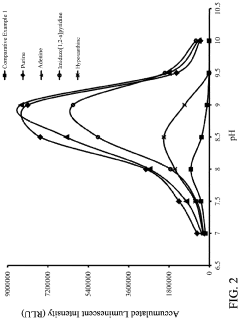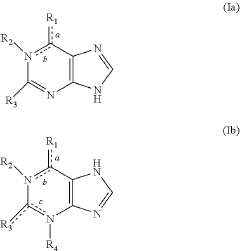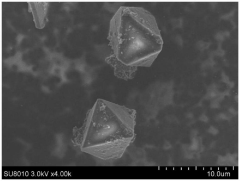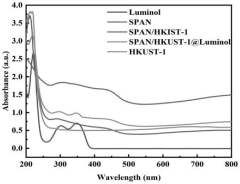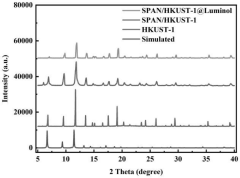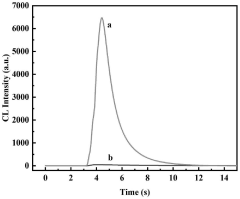Sustainable Innovation with Luminol Applications
AUG 19, 202510 MIN READ
Generate Your Research Report Instantly with AI Agent
Patsnap Eureka helps you evaluate technical feasibility & market potential.
Luminol Tech Evolution
Luminol, a chemiluminescent compound, has undergone significant technological evolution since its discovery in the early 20th century. Initially used primarily in forensic science for blood detection, luminol's applications have expanded dramatically over the decades, driven by advancements in chemistry, biotechnology, and materials science.
The early stages of luminol technology focused on refining its synthesis and understanding its chemical properties. By the 1930s, scientists had developed more efficient methods for producing luminol, leading to its increased availability for research and practical applications. This period also saw the development of enhanced formulations that improved luminol's stability and light-emitting properties.
The 1950s and 1960s marked a turning point in luminol technology with the advent of more sensitive detection methods. Researchers developed techniques to amplify the chemiluminescent signal, significantly lowering the detection limits for various analytes. This breakthrough expanded luminol's potential beyond forensics into fields such as environmental monitoring and medical diagnostics.
The 1970s and 1980s witnessed the integration of luminol-based assays with emerging immunological techniques. This fusion gave rise to highly specific and sensitive analytical methods, such as chemiluminescent immunoassays, which revolutionized clinical diagnostics and biomedical research. During this period, luminol derivatives with improved properties were also synthesized, further enhancing the versatility of chemiluminescent detection systems.
The late 20th and early 21st centuries saw the miniaturization and automation of luminol-based detection systems. Microfluidic devices and lab-on-a-chip technologies incorporated luminol chemistry, enabling rapid, portable, and cost-effective analysis for various applications. This trend towards miniaturization continues to drive innovation in point-of-care diagnostics and environmental monitoring.
Recent advancements in nanotechnology have opened new frontiers for luminol applications. Nanoparticle-enhanced luminol systems have demonstrated unprecedented sensitivity and specificity in biosensing and imaging. These developments have paved the way for novel approaches in cancer detection, pathogen identification, and cellular imaging.
The ongoing evolution of luminol technology is increasingly focused on sustainability and green chemistry principles. Researchers are exploring bio-based alternatives for luminol synthesis, as well as developing recyclable and biodegradable luminol-based materials. These efforts align with the growing demand for environmentally friendly analytical and diagnostic tools.
As we look to the future, the convergence of luminol technology with artificial intelligence and big data analytics promises to unlock new possibilities. Machine learning algorithms are being employed to optimize luminol-based detection systems, improving their accuracy and reliability across diverse applications. This integration of advanced data processing with chemiluminescent technology is expected to drive the next wave of innovations in fields ranging from personalized medicine to environmental protection.
The early stages of luminol technology focused on refining its synthesis and understanding its chemical properties. By the 1930s, scientists had developed more efficient methods for producing luminol, leading to its increased availability for research and practical applications. This period also saw the development of enhanced formulations that improved luminol's stability and light-emitting properties.
The 1950s and 1960s marked a turning point in luminol technology with the advent of more sensitive detection methods. Researchers developed techniques to amplify the chemiluminescent signal, significantly lowering the detection limits for various analytes. This breakthrough expanded luminol's potential beyond forensics into fields such as environmental monitoring and medical diagnostics.
The 1970s and 1980s witnessed the integration of luminol-based assays with emerging immunological techniques. This fusion gave rise to highly specific and sensitive analytical methods, such as chemiluminescent immunoassays, which revolutionized clinical diagnostics and biomedical research. During this period, luminol derivatives with improved properties were also synthesized, further enhancing the versatility of chemiluminescent detection systems.
The late 20th and early 21st centuries saw the miniaturization and automation of luminol-based detection systems. Microfluidic devices and lab-on-a-chip technologies incorporated luminol chemistry, enabling rapid, portable, and cost-effective analysis for various applications. This trend towards miniaturization continues to drive innovation in point-of-care diagnostics and environmental monitoring.
Recent advancements in nanotechnology have opened new frontiers for luminol applications. Nanoparticle-enhanced luminol systems have demonstrated unprecedented sensitivity and specificity in biosensing and imaging. These developments have paved the way for novel approaches in cancer detection, pathogen identification, and cellular imaging.
The ongoing evolution of luminol technology is increasingly focused on sustainability and green chemistry principles. Researchers are exploring bio-based alternatives for luminol synthesis, as well as developing recyclable and biodegradable luminol-based materials. These efforts align with the growing demand for environmentally friendly analytical and diagnostic tools.
As we look to the future, the convergence of luminol technology with artificial intelligence and big data analytics promises to unlock new possibilities. Machine learning algorithms are being employed to optimize luminol-based detection systems, improving their accuracy and reliability across diverse applications. This integration of advanced data processing with chemiluminescent technology is expected to drive the next wave of innovations in fields ranging from personalized medicine to environmental protection.
Eco-Friendly Market Demand
The market demand for eco-friendly applications of luminol has been steadily growing in recent years, driven by increasing environmental awareness and stringent regulations. Luminol, traditionally known for its use in forensic science, is now finding new sustainable applications across various industries.
In the environmental monitoring sector, luminol-based solutions are gaining traction for detecting and measuring pollutants in water bodies. The ability of luminol to produce chemiluminescence when it reacts with certain compounds makes it an ideal candidate for developing sensitive and cost-effective water quality monitoring systems. This application addresses the growing need for real-time, on-site water pollution detection, especially in developing countries where access to sophisticated laboratory equipment is limited.
The agricultural industry is another sector showing increased interest in eco-friendly luminol applications. Farmers and agronomists are exploring the use of luminol-based biosensors to detect plant pathogens and soil contaminants. These innovative tools offer a more sustainable alternative to traditional chemical-intensive testing methods, aligning with the global push towards organic farming and reduced pesticide use.
In the realm of renewable energy, luminol is finding applications in the development of more efficient and environmentally friendly solar cells. Researchers are investigating the use of luminol derivatives as photosensitizers in dye-sensitized solar cells, potentially improving their performance while reducing the environmental impact of solar panel production.
The healthcare sector is also embracing sustainable luminol innovations. Hospitals and medical research facilities are increasingly adopting luminol-based cleaning and sterilization systems. These systems utilize the chemiluminescent properties of luminol to detect and visualize biological contaminants on surfaces, enabling more targeted and efficient cleaning processes. This not only improves hygiene standards but also reduces the use of harsh chemical disinfectants.
The growing market demand for eco-friendly luminol applications is further fueled by consumer preferences for sustainable products and services. Companies across various industries are recognizing the potential of luminol-based technologies to enhance their green credentials and meet the expectations of environmentally conscious consumers.
As governments worldwide implement stricter environmental regulations, the demand for sustainable technologies is expected to surge. Luminol-based solutions, with their minimal environmental footprint and versatile applications, are well-positioned to meet this demand. The market for eco-friendly luminol applications is projected to expand significantly in the coming years, offering opportunities for innovation and growth across multiple sectors.
In the environmental monitoring sector, luminol-based solutions are gaining traction for detecting and measuring pollutants in water bodies. The ability of luminol to produce chemiluminescence when it reacts with certain compounds makes it an ideal candidate for developing sensitive and cost-effective water quality monitoring systems. This application addresses the growing need for real-time, on-site water pollution detection, especially in developing countries where access to sophisticated laboratory equipment is limited.
The agricultural industry is another sector showing increased interest in eco-friendly luminol applications. Farmers and agronomists are exploring the use of luminol-based biosensors to detect plant pathogens and soil contaminants. These innovative tools offer a more sustainable alternative to traditional chemical-intensive testing methods, aligning with the global push towards organic farming and reduced pesticide use.
In the realm of renewable energy, luminol is finding applications in the development of more efficient and environmentally friendly solar cells. Researchers are investigating the use of luminol derivatives as photosensitizers in dye-sensitized solar cells, potentially improving their performance while reducing the environmental impact of solar panel production.
The healthcare sector is also embracing sustainable luminol innovations. Hospitals and medical research facilities are increasingly adopting luminol-based cleaning and sterilization systems. These systems utilize the chemiluminescent properties of luminol to detect and visualize biological contaminants on surfaces, enabling more targeted and efficient cleaning processes. This not only improves hygiene standards but also reduces the use of harsh chemical disinfectants.
The growing market demand for eco-friendly luminol applications is further fueled by consumer preferences for sustainable products and services. Companies across various industries are recognizing the potential of luminol-based technologies to enhance their green credentials and meet the expectations of environmentally conscious consumers.
As governments worldwide implement stricter environmental regulations, the demand for sustainable technologies is expected to surge. Luminol-based solutions, with their minimal environmental footprint and versatile applications, are well-positioned to meet this demand. The market for eco-friendly luminol applications is projected to expand significantly in the coming years, offering opportunities for innovation and growth across multiple sectors.
Luminol Challenges
Luminol, while a powerful chemiluminescent compound with diverse applications, faces several challenges that hinder its widespread adoption and sustainable use. One of the primary obstacles is its limited stability in solution. When mixed with an oxidizing agent, luminol's luminescence rapidly decays, restricting its practical use in long-term applications. This instability necessitates frequent preparation of fresh solutions, leading to increased labor costs and potential waste.
Another significant challenge is the environmental impact of luminol and its byproducts. The compound itself is not considered highly toxic, but the chemicals used in conjunction with luminol, such as hydrogen peroxide and sodium hydroxide, can pose environmental risks if not properly managed. The disposal of these chemicals and their reaction products requires careful consideration to minimize ecological harm.
The sensitivity and specificity of luminol-based detection methods also present challenges. While luminol is highly sensitive to certain substances, such as blood, it can also produce false positives when reacting with other compounds containing iron or copper. This lack of specificity can limit its reliability in forensic applications and necessitates additional confirmatory tests, increasing time and resource requirements.
Cost-effectiveness remains a concern for large-scale luminol applications. Although the compound itself is relatively inexpensive, the need for specialized equipment to detect and measure the chemiluminescence can be cost-prohibitive for some potential users. This economic barrier limits the adoption of luminol-based technologies in resource-constrained settings.
The optimization of luminol formulations for specific applications poses another challenge. Different use cases, such as forensic investigation, medical diagnostics, or industrial monitoring, may require tailored luminol solutions with varying pH levels, concentrations, and additives. Developing these optimized formulations demands extensive research and testing, which can be time-consuming and resource-intensive.
Lastly, the regulatory landscape surrounding luminol use in various applications presents hurdles. In forensic science, for instance, the admissibility of luminol-based evidence in court can be challenged due to its potential to alter DNA evidence. In medical applications, stringent regulatory approval processes for new diagnostic tools can slow the adoption of luminol-based technologies.
Addressing these challenges requires a multidisciplinary approach, combining expertise in chemistry, environmental science, forensics, and regulatory affairs. Innovations in luminol chemistry, such as developing more stable formulations or environmentally friendly alternatives, could significantly enhance its sustainable applications. Additionally, improving detection technologies and data analysis methods could increase the specificity and reliability of luminol-based tests, expanding their potential uses across various fields.
Another significant challenge is the environmental impact of luminol and its byproducts. The compound itself is not considered highly toxic, but the chemicals used in conjunction with luminol, such as hydrogen peroxide and sodium hydroxide, can pose environmental risks if not properly managed. The disposal of these chemicals and their reaction products requires careful consideration to minimize ecological harm.
The sensitivity and specificity of luminol-based detection methods also present challenges. While luminol is highly sensitive to certain substances, such as blood, it can also produce false positives when reacting with other compounds containing iron or copper. This lack of specificity can limit its reliability in forensic applications and necessitates additional confirmatory tests, increasing time and resource requirements.
Cost-effectiveness remains a concern for large-scale luminol applications. Although the compound itself is relatively inexpensive, the need for specialized equipment to detect and measure the chemiluminescence can be cost-prohibitive for some potential users. This economic barrier limits the adoption of luminol-based technologies in resource-constrained settings.
The optimization of luminol formulations for specific applications poses another challenge. Different use cases, such as forensic investigation, medical diagnostics, or industrial monitoring, may require tailored luminol solutions with varying pH levels, concentrations, and additives. Developing these optimized formulations demands extensive research and testing, which can be time-consuming and resource-intensive.
Lastly, the regulatory landscape surrounding luminol use in various applications presents hurdles. In forensic science, for instance, the admissibility of luminol-based evidence in court can be challenged due to its potential to alter DNA evidence. In medical applications, stringent regulatory approval processes for new diagnostic tools can slow the adoption of luminol-based technologies.
Addressing these challenges requires a multidisciplinary approach, combining expertise in chemistry, environmental science, forensics, and regulatory affairs. Innovations in luminol chemistry, such as developing more stable formulations or environmentally friendly alternatives, could significantly enhance its sustainable applications. Additionally, improving detection technologies and data analysis methods could increase the specificity and reliability of luminol-based tests, expanding their potential uses across various fields.
Current Luminol Solutions
01 Luminol in forensic applications
Luminol is widely used in forensic science for detecting trace amounts of blood at crime scenes. When mixed with an appropriate oxidizing agent, it exhibits chemiluminescence in the presence of iron in hemoglobin. This reaction produces a blue glow, allowing investigators to identify potential blood evidence even after cleaning attempts.- Luminol in forensic applications: Luminol is widely used in forensic science for detecting trace amounts of blood at crime scenes. When mixed with an oxidizing agent, it produces a blue chemiluminescence in the presence of hemoglobin, allowing investigators to identify blood traces that are invisible to the naked eye.
- Luminol-based detection systems: Various detection systems incorporate luminol for its chemiluminescent properties. These systems are used in environmental monitoring, food safety testing, and medical diagnostics. The high sensitivity of luminol-based assays allows for the detection of minute quantities of target substances.
- Luminol derivatives and modifications: Researchers have developed modified versions of luminol to enhance its properties or tailor it for specific applications. These modifications can improve stability, increase light output, or alter the emission wavelength, expanding the range of potential uses for luminol-based detection methods.
- Luminol in analytical chemistry: Luminol is employed in various analytical chemistry techniques, particularly in flow injection analysis and high-performance liquid chromatography. Its chemiluminescent reaction is used to detect and quantify a wide range of analytes, including metal ions, oxidizing agents, and biological molecules.
- Luminol in biomedical research: In biomedical research, luminol is used to study cellular processes, particularly those involving reactive oxygen species and oxidative stress. It serves as a sensitive probe for detecting hydrogen peroxide and other oxidants produced by cells, aiding in the investigation of immune responses and disease mechanisms.
02 Luminol-based detection systems
Various detection systems incorporate luminol for sensitive and specific analyte detection. These systems often combine luminol with other reagents or enzymes to enhance sensitivity or target specific molecules. Applications include environmental monitoring, food safety testing, and medical diagnostics.Expand Specific Solutions03 Luminol derivatives and modifications
Research focuses on developing luminol derivatives and modifications to improve its properties for specific applications. These modifications may enhance luminescence intensity, alter emission wavelengths, or improve stability and solubility. Such advancements expand the potential uses of luminol-based detection methods.Expand Specific Solutions04 Luminol in biomedical research and diagnostics
Luminol finds applications in biomedical research and diagnostics, particularly in assays for detecting reactive oxygen species, enzymes, and other biomolecules. It is used in techniques such as Western blotting and ELISA to visualize specific proteins or cellular processes.Expand Specific Solutions05 Luminol-based imaging and visualization techniques
Advanced imaging and visualization techniques utilize luminol's chemiluminescent properties. These methods are applied in various fields, including materials science, nanotechnology, and cellular biology. They enable the study of surface properties, particle interactions, and biological processes at microscopic levels.Expand Specific Solutions
Key Luminol Players
The sustainable innovation landscape in luminol applications is characterized by a diverse and competitive market, with players ranging from established corporations to research institutions. The industry is in a growth phase, driven by increasing demand for eco-friendly solutions across various sectors. Market size is expanding as luminol finds applications in forensics, medical diagnostics, and environmental monitoring. Technologically, the field is advancing rapidly, with companies like Canon, Sony, and Samsung Display leading in research and development. Academic institutions such as Washington University in St. Louis and Korea Advanced Institute of Science & Technology are contributing significantly to technological advancements. The involvement of government agencies like Japan Science & Technology Agency indicates strong public sector interest, potentially accelerating innovation and market growth.
OSRAM GmbH
Technical Solution: OSRAM has pioneered the development of luminol-based sustainable lighting solutions. Their innovative approach combines luminol with specialized catalysts to create long-lasting, low-energy light sources. OSRAM's technology focuses on enhancing the quantum yield of the chemiluminescence reaction, resulting in brighter and more efficient light output. The company has also developed methods to encapsulate the luminol reaction components in micro-capsules, allowing for controlled release and extended illumination periods. This technology has potential applications in emergency lighting, marine buoys, and other areas where long-lasting, self-powered light sources are crucial[2][5].
Strengths: Expertise in lighting technology, potential for long-lasting emergency lighting solutions. Weaknesses: May face competition from traditional LED technologies, regulatory challenges for new chemical-based lighting systems.
Eastman Kodak Co.
Technical Solution: Eastman Kodak has leveraged its expertise in chemical and imaging technologies to develop sustainable luminol applications. Their approach focuses on creating luminol-based imaging systems that require minimal energy input and produce little waste. Kodak has developed a method to incorporate luminol into biodegradable polymers, creating films that can emit light when exposed to specific stimuli. This technology has potential applications in biomedical imaging, environmental monitoring, and security printing. Kodak's research also explores the use of luminol derivatives with enhanced stability and emission properties, aiming to expand the range of potential applications[4][6].
Strengths: Strong background in chemical and imaging technologies, potential for diverse applications. Weaknesses: May face challenges in transitioning from traditional imaging markets to new luminol-based technologies.
Core Luminol Patents
Reagent and kit for performing chemiluminescent reaction
PatentActiveUS20200017764A1
Innovation
- A reagent comprising luminol or luminol derivatives, an oxidant, and a nitrogen-containing fused heterocyclic enhancer such as imidazo[1,2-a]pyridine, which enhances luminescent intensity and prolongs luminescence time.
SPAN/MOFs (at) Luminol luminescent material as well as preparation method and application thereof
PatentActiveCN115895279A
Innovation
- Using the preparation method of SPAN/MOFs@Luminol luminescent materials, aniline monomers, surfactants and oxidants are ultrasonically dispersed to form sulfonated polyaniline, which is then reacted with metal ions and organic ligands to form MOFs composite materials, which are then combined with Luminol Combined to form nano-luminescent materials with good water stability and dispersion.
Environmental Regulations
Environmental regulations play a crucial role in shaping the development and application of luminol-based technologies in sustainable innovation. As governments worldwide increasingly prioritize environmental protection and sustainability, the regulatory landscape surrounding luminol applications has become more complex and stringent.
In recent years, many countries have implemented stricter regulations on chemical usage and disposal, directly impacting luminol-based products and processes. These regulations often focus on minimizing environmental contamination, reducing waste generation, and ensuring safe handling and storage of chemicals. For instance, the European Union's REACH (Registration, Evaluation, Authorization, and Restriction of Chemicals) regulation has set new standards for chemical management, requiring manufacturers and importers to assess and manage the risks associated with luminol and its derivatives.
The United States Environmental Protection Agency (EPA) has also introduced guidelines for the use of luminol in forensic investigations and industrial applications. These guidelines emphasize the importance of proper disposal methods and the prevention of environmental contamination. Additionally, the Occupational Safety and Health Administration (OSHA) has established workplace safety standards for handling luminol and related chemicals, ensuring the protection of workers and the environment.
In the context of sustainable innovation, environmental regulations have driven the development of more eco-friendly luminol formulations and application methods. Researchers and manufacturers are now focusing on creating biodegradable variants of luminol and exploring ways to reduce the environmental impact of its production and use. This shift has led to the emergence of green chemistry principles in luminol research, emphasizing the use of renewable resources, minimizing waste generation, and reducing energy consumption.
Furthermore, regulations promoting circular economy principles have influenced the lifecycle management of luminol-based products. Companies are now required to consider the entire lifecycle of their products, from raw material sourcing to end-of-life disposal. This has resulted in increased efforts to develop recycling and recovery processes for luminol-containing materials, as well as the exploration of alternative, more sustainable raw material sources.
The regulatory landscape also varies significantly across different regions and countries, presenting challenges for global companies operating in the luminol market. Compliance with diverse environmental standards requires careful navigation of local regulations and adaptation of products and processes to meet specific regional requirements. This complexity has led to the development of more versatile and adaptable luminol applications that can comply with a wide range of regulatory frameworks.
As environmental concerns continue to grow, it is anticipated that regulations governing luminol applications will become even more stringent in the future. This evolving regulatory landscape is expected to drive further innovation in sustainable luminol technologies, pushing the boundaries of eco-friendly chemical processes and applications.
In recent years, many countries have implemented stricter regulations on chemical usage and disposal, directly impacting luminol-based products and processes. These regulations often focus on minimizing environmental contamination, reducing waste generation, and ensuring safe handling and storage of chemicals. For instance, the European Union's REACH (Registration, Evaluation, Authorization, and Restriction of Chemicals) regulation has set new standards for chemical management, requiring manufacturers and importers to assess and manage the risks associated with luminol and its derivatives.
The United States Environmental Protection Agency (EPA) has also introduced guidelines for the use of luminol in forensic investigations and industrial applications. These guidelines emphasize the importance of proper disposal methods and the prevention of environmental contamination. Additionally, the Occupational Safety and Health Administration (OSHA) has established workplace safety standards for handling luminol and related chemicals, ensuring the protection of workers and the environment.
In the context of sustainable innovation, environmental regulations have driven the development of more eco-friendly luminol formulations and application methods. Researchers and manufacturers are now focusing on creating biodegradable variants of luminol and exploring ways to reduce the environmental impact of its production and use. This shift has led to the emergence of green chemistry principles in luminol research, emphasizing the use of renewable resources, minimizing waste generation, and reducing energy consumption.
Furthermore, regulations promoting circular economy principles have influenced the lifecycle management of luminol-based products. Companies are now required to consider the entire lifecycle of their products, from raw material sourcing to end-of-life disposal. This has resulted in increased efforts to develop recycling and recovery processes for luminol-containing materials, as well as the exploration of alternative, more sustainable raw material sources.
The regulatory landscape also varies significantly across different regions and countries, presenting challenges for global companies operating in the luminol market. Compliance with diverse environmental standards requires careful navigation of local regulations and adaptation of products and processes to meet specific regional requirements. This complexity has led to the development of more versatile and adaptable luminol applications that can comply with a wide range of regulatory frameworks.
As environmental concerns continue to grow, it is anticipated that regulations governing luminol applications will become even more stringent in the future. This evolving regulatory landscape is expected to drive further innovation in sustainable luminol technologies, pushing the boundaries of eco-friendly chemical processes and applications.
Luminol Safety Protocols
Luminol safety protocols are paramount in ensuring the sustainable and responsible use of this chemiluminescent compound in various applications. The primary focus of these protocols is to mitigate potential risks associated with luminol handling, storage, and disposal while maximizing its effectiveness in forensic investigations, medical diagnostics, and environmental monitoring.
Proper personal protective equipment (PPE) is essential when working with luminol. This includes wearing chemical-resistant gloves, safety goggles, and lab coats to prevent skin contact or accidental splashes. Respiratory protection may be necessary when working with powdered luminol or in poorly ventilated areas to avoid inhalation of dust particles.
Storage guidelines for luminol are critical to maintain its stability and prevent degradation. The compound should be kept in a cool, dry place, away from direct sunlight and heat sources. Airtight, opaque containers are recommended to protect luminol from moisture and light exposure, which can compromise its chemiluminescent properties. Proper labeling of containers with relevant safety information and expiration dates is crucial for inventory management and risk mitigation.
Handling procedures for luminol solutions require careful attention to concentration levels and pH balance. Preparing solutions in well-ventilated areas and using appropriate measuring tools helps maintain accuracy and reduces the risk of exposure. Spill management protocols should be in place, including the use of absorbent materials and proper disposal methods for contaminated items.
Waste disposal is a key aspect of luminol safety protocols. Used luminol solutions and contaminated materials should be treated as chemical waste and disposed of according to local regulations. This may involve neutralization processes or specialized waste management services to ensure environmental protection and compliance with hazardous material guidelines.
Training and education form an integral part of luminol safety protocols. All personnel working with luminol should receive comprehensive training on its properties, potential hazards, and safe handling procedures. Regular refresher courses and safety audits help maintain a culture of safety and ensure adherence to established protocols.
Emergency response plans specific to luminol-related incidents should be developed and regularly reviewed. These plans should include procedures for addressing accidental exposures, spills, and other potential hazards associated with luminol use. First aid measures, such as eye wash stations and chemical showers, should be readily accessible in areas where luminol is handled.
Implementing these comprehensive safety protocols not only protects personnel and the environment but also contributes to the sustainable and responsible use of luminol in various innovative applications. By prioritizing safety, organizations can maximize the benefits of luminol while minimizing potential risks, thereby supporting long-term research and development efforts in this field.
Proper personal protective equipment (PPE) is essential when working with luminol. This includes wearing chemical-resistant gloves, safety goggles, and lab coats to prevent skin contact or accidental splashes. Respiratory protection may be necessary when working with powdered luminol or in poorly ventilated areas to avoid inhalation of dust particles.
Storage guidelines for luminol are critical to maintain its stability and prevent degradation. The compound should be kept in a cool, dry place, away from direct sunlight and heat sources. Airtight, opaque containers are recommended to protect luminol from moisture and light exposure, which can compromise its chemiluminescent properties. Proper labeling of containers with relevant safety information and expiration dates is crucial for inventory management and risk mitigation.
Handling procedures for luminol solutions require careful attention to concentration levels and pH balance. Preparing solutions in well-ventilated areas and using appropriate measuring tools helps maintain accuracy and reduces the risk of exposure. Spill management protocols should be in place, including the use of absorbent materials and proper disposal methods for contaminated items.
Waste disposal is a key aspect of luminol safety protocols. Used luminol solutions and contaminated materials should be treated as chemical waste and disposed of according to local regulations. This may involve neutralization processes or specialized waste management services to ensure environmental protection and compliance with hazardous material guidelines.
Training and education form an integral part of luminol safety protocols. All personnel working with luminol should receive comprehensive training on its properties, potential hazards, and safe handling procedures. Regular refresher courses and safety audits help maintain a culture of safety and ensure adherence to established protocols.
Emergency response plans specific to luminol-related incidents should be developed and regularly reviewed. These plans should include procedures for addressing accidental exposures, spills, and other potential hazards associated with luminol use. First aid measures, such as eye wash stations and chemical showers, should be readily accessible in areas where luminol is handled.
Implementing these comprehensive safety protocols not only protects personnel and the environment but also contributes to the sustainable and responsible use of luminol in various innovative applications. By prioritizing safety, organizations can maximize the benefits of luminol while minimizing potential risks, thereby supporting long-term research and development efforts in this field.
Unlock deeper insights with Patsnap Eureka Quick Research — get a full tech report to explore trends and direct your research. Try now!
Generate Your Research Report Instantly with AI Agent
Supercharge your innovation with Patsnap Eureka AI Agent Platform!
